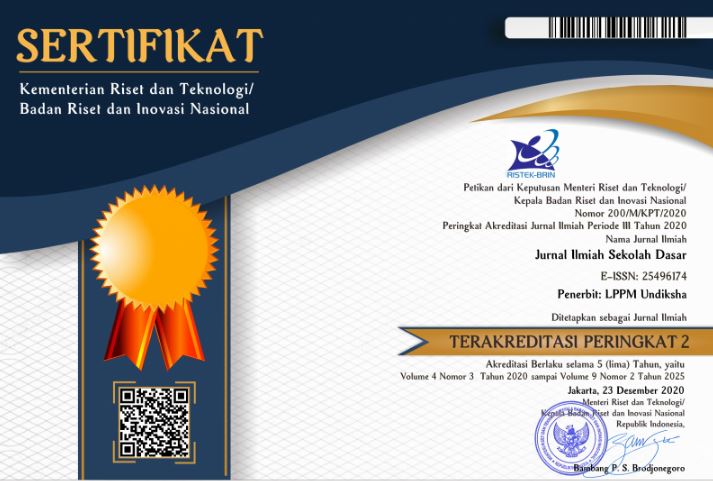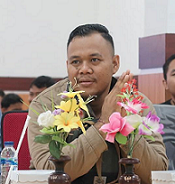Learning Effectiveness of Guided Science to Improve Student Learning Outcomes
DOI:
https://doi.org/10.23887/jisd.v4i3.27985Keywords:
discovery of guided science, science learning outcomesAbstract
The low learning outcomes of students in Natural Science is the main problem in this study. It is due to the ineffective science learning system in its application so that students are less interested in learning science. This study aimed to determine the effectiveness of using guided science discovery learning in improving learning outcomes of fifth grade elementary school students. The method used in this research is pre-experimental one group pretest-posttest design. The sampling technique used nonprobability sampling model, namely purposive sampling. The data analysis used was the effectiveness test using the paired sample t-test assisted by SPSS 21 through comparing the sig (2-tailed) value with an alpha value of 5%. The number of samples used was 28 students. The research instrument was a multiple-choice test and a questionnaire. The results showed that the mean pretest value was 59.29 and the posttest value was 0.082; the pretest significance was 0.126, the significance for the posttest was 0,082; the significance of guided science discovery learning was 0,200, each of which has a significance value of 0,000 <0, 05. It means that there is a significant difference, while the t value is 12,515. It means that the pretest score is smaller than the posttest, which is 12,515, so it can be stated that guided science discovery learning is effective in improving student learning outcomes. Thus, it can be concluded that there is a positive and significant effect of guided science discovery on learning outcomes of fifth grade elementary school students.
References
Ardithayasa, W., & Yudiana, K. (2020). Model Pembelajaran Group Investigation (GI) Berbasis Tri Hita Karana Terhadap Hasil Belajar IPA. Jurnal Ilmiah Sekolah Dasar, 4(2), 163–173. http://dx.doi.org/10.23887/jisd.v4i2.25105
Asta, I. K. R., Agung, A. A. G., & Widiana, I. W. (2015). Pengaruh Pendekatan Saintifik dan Kemampuan Berpikir Kritis terhadap Hasil Belajar IPA. E-Journal PGSD Universitas Pendidikan Ganesha, 3(1), 1–10. http://dx.doi.org/10.23887/jjpgsd.v3i1.5637
Bayu, G. W., & Wahyuni, L. G. E. (2019). Efektifitas Implementasi Strategi Enjoyable Learning Berbantuan Media Audio Visual Terhadap Hasil Belajar Bahasa Inggris Permulaan Peserta Didik Sekolah Dasar. Jurnal Ilmiah Sekolah Dasar, 3(3), 335–341. http://dx.doi.org/10.23887/jisd.v3i3.16015
Hadinata, L. W., Utaya, S., & Setyosari, P. (2017). Pengaruh Pembelajaran Student Team Achievement Division dan Diskusi terhadap Hasil Belajar IPA Kelas IV SD. Jurnal Pendidikan: Teori, Penelitian, Dan Pengembangan, 2(7), 979–985. http://dx.doi.org/10.17977/jptpp.v2i7.9693
Hanafiah, & Suhana. (2010). Konsep Strategi Pembelajaran. Bandung: Rafika Aditama.
Harianti, F. (2018). Pengaruh Model Pembelajaran Guided Discovery Learning Terhadap Kemampuan Pemahaman Dan Hasil Belajar Siswa Materi Operasi Aljabar Kelas VII SMP Ferennita Harianti Institut Agama Islam Negeri ( IAIN ) Tulungagung Pendahuluan Menurut Undang-Undang Nomor 20. MUST: Journal of Mathematics Education, Science and Technology, 3(1), 82–91. http://dx.doi.org/10.30651/must.v3i1.1611
Hazmiwati, H. (2018). Penerapan Model Pembelajaran Kooperatif Tipe Stad Untuk Meningkatkan Hasil Belajar IPA Siswa Kelas Ii Sekolah Dasar. Primary: Jurnal Pendidikan Guru Sekolah Dasar, 7(1), 178. https://doi.org/10.33578/jpfkip.v7i1.5359
Herlily, V., Anhar, A., Ahda, Y., & Sumarmin, R. (2018). Application of Learning Model Learning Guided Discovery with Scientific Approach to Enhance Learning Competency Science Seventh Grade Students. International Journal of Progressive Sciences and Technologies, 6(2), 499–505. https://ijpsat.ijsht-journals.org/index.php/ijpsat/article/view/274
Jonkenedi. (2017). Penggunaan Media Tiga Dimensi untuk Meningkatkan Keaktifan Siswa dalam Pembelajaran IPA. Jurnal Pendidikan Guru Sekolah Dasar, 6(6), 590–598.
Juniantari, I, G, A, S., & Kusmariyatni, N. N. (2019). Pengaruh Model Pembelajaran Koperatif Two Stay Two Stray Berbantuan Mind Mapping Terhadap Hasil Belajar IPA. Jurnal Ilmiah Sekolah Dasar, 3(3), 370–377.
Khaerudin, & Junaedi, M. (2007). Kurikulum Tingkat Satuan Pendidikan (KTSP) Konsep Dan Implementasinya di Madrasah. Semarang: Pilar Media.
Khaidir, C. (2013). Penerapan Metode Penemuan Terbimbing Dalam Pembelajaran Matematika Di Sma Negeri 2 Padang. Ta’dib, 16(2), 103–115. https://doi.org/10.31958/jt.v16i2.243
Kristinawati, D., Akbar, S., & Mahanal, S. (2017). Implementasi Model Brain Based Learning dengan Mind Map Pada Pembelajaran IPA Kelas V Sekolah Dasar. Prosiding TEP & PDs Transformasi Pendidikan Abad 21, 6(11), 637–644.
Lestari, D., Sudrajat, R., & Setia, M. Y. (2019). Implementasi Model Numbered Heads Together Terhadap Hasil Belajar Siswa Kelas IV SD Pada Materi Faktor Persekutuan Besar Dan Kelipatan Persekutuan Terkecil. Jurnal Ilmiah Sekolah Dasar, 3(4), 413–420. http://dx.doi.org/10.23887/jisd.v3i4.21776
Mirasi, W., Osodo, J., & Kibirige, I. (2013). Comparing Guided Discovery and Exposition with Interaction Methods In Teaching Biology In Secondary Schools. Journal of Social Science, 4(14), 81–87. http://www.richtmann.org/journal/index.php/mjss/article/view/1579
Nasri, Khaidun, I., & Mursal. (2015). Penerapan Model Penemuan Terbimbing Dalam Meningkatkan Hasil Belajar Siswa Kelas VIII MTsN Sigli Pada Konsep Cahaya Dan Mata. Jurnal Pendidikan Sains Indonesia, 3(2), 135. http://jurnal.unsyiah.ac.id/JPSI/article/view/7658
Nupita, E. (2013). Penerapan Model Pembelajaran Penemuan Terbimbing Untuk Meningkatkan Hasil Belajar Dan Keterampilan Pemecahan Masalah IPA Pada Kelas V Sekolah Dasar. JPGSD, 1(2), 7.
Paolini, A. (2015). Enhancing Teaching Effectiveness And Student Learning Outcomes. Journal of Effective Teaching, 15(1), 20–33.
Pardede, O., Motlan, & Suryanti, R. D. (2016). Efek Model Pembelajaran Guided Discovery Berbasis Kolaborasi Dengan Media Flash Terhadap Keterampilan Proses Sains dan Hasil Belajar Kognitif Tinggi Fisika Siswa SMA. Jurnal Pendidikan Fisika, 5(1), 12–17. https://doi.org/10.22611/jpf.v5i1.3700
Sobarna, E., Darmawan, D., & Hudiana. (2014). Efektifitas Penggunaan Multimedia Interaktif (MMI) Model Tutorial Terhadap Motivasi Serta Hasil Belajar Peserta Didik Pada Materi Pelajaran Ilmu Pengetahuan Alam Pokok Bahasan Sistem Pernapasan Manusia. Edutech, 1(3), 386–399.
Sophuan. (2018). Peningkatkan Keterampilan Mengajar Guru SMP Mata Pelajaran IPA Dalam Menerapkan Pendekatan Saintifik. Tadrib, 4(2), 335–355. https://doi.org/https://doi.org/10.19109/tadrib.v4i2.2860
Sugiyono. (2015). Strategi Pembelajaran Berorientasi Standar Proses Pendidikan. Jakarta: Kencana.
Sulistyorini, S., & Suparton. (2007). Model Pembelajaran IPA Sekolah Dasar Dan Penerapannya dalam KTSP. Yogyakarta: Tiara Wacana.
Sulthon. (2016). Pembelajaran IPA Yang Efektif Dan Menyenangkan Bagi Siswa Madrasah Ibtidaiyah (MI). Jurnal STAIN, 4(1), 43.
Surahman, Paudi, R. I., & Dewi, T. (2013). Meningkatkan Hasil Belajar Siswa Dalam Pembelajaran IPA Pokok Bahasan Makhluk Hidup Dan Proses Kehidupan Melalui Media Gambar Konstektual Pada Siswa Kelas II SD Alkhairaat Towera. Jurnal Kreatif Tadulako Online, 3(4), 92–93.
Tias, I. W. (2017). Penerapan Model Penemuan Terbimbing Untuk Meningkatkan Hasil Belajar IPA Siswa Sekolah Dasar. DWIJACENDEKIA Jurnal Riset Pedagogik, 1(1), 59.
Yupriyanti, N. L. (2015). Pengaruh Model Pembelajaran Generatif Berbantuan Media Konkret Terhadap Hasil Belajar IPA Siswa Kelas V Sd Gugus 1 Manggis Kecamatan Manggis Kabupaten Karangasem Tahun Ajaran 2014/2015. MIMBAR PGSD Undiksha, 3(1). https://doi.org/10.23887/jjpgsd.v3i1.4825
Downloads
Published
How to Cite
Issue
Section
License
Authors who publish with the Journal Ilmiah Sekolah Dasar agree to the following terms:
- Authors retain copyright and grant the journal the right of first publication with the work simultaneously licensed under a Creative Commons Attribution License (CC BY-SA 4.0) that allows others to share the work with an acknowledgment of the work's authorship and initial publication in this journal.
- Authors are able to enter into separate, additional contractual arrangements for the non-exclusive distribution of the journal's published version of the work (e.g., post it to an institutional repository or publish it in a book), with an acknowledgment of its initial publication in this journal.
- Authors are permitted and encouraged to post their work online (e.g., in institutional repositories or on their website) prior to and during the submission process, as it can lead to productive exchanges, as well as earlier and greater citation of published work. (See The Effect of Open Access)










